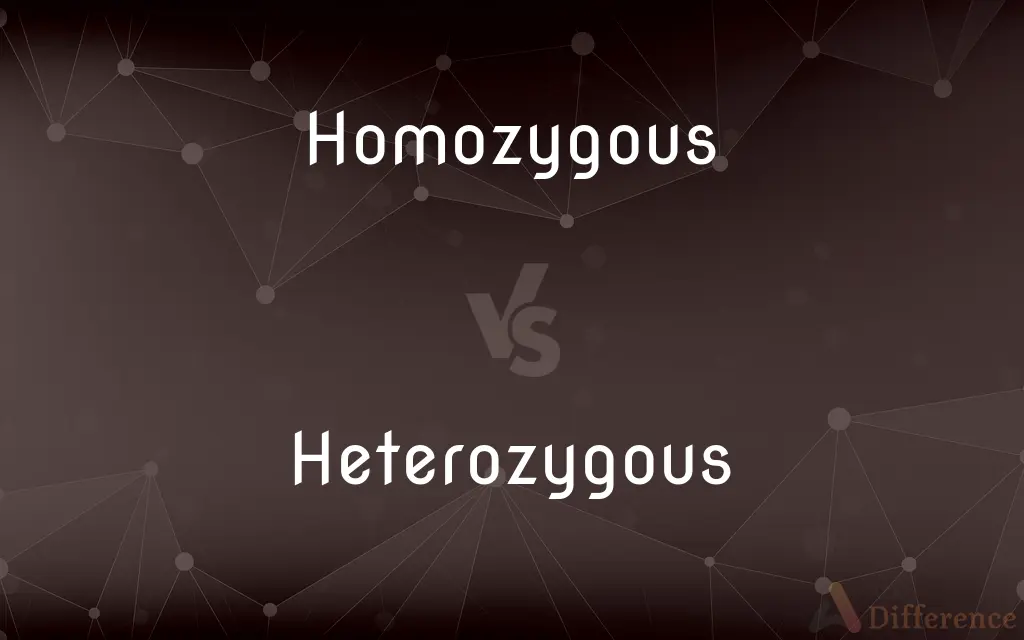Homozygous vs. Heterozygous — What's the Difference?
By Tayyaba Rehman & Urooj Arif — Updated on April 21, 2024
Homozygous alleles are identical in an organism’s genotype, promoting genetic stability, while heterozygous alleles vary, increasing diversity.

Difference Between Homozygous and Heterozygous
Table of Contents
ADVERTISEMENT
Key Differences
Homozygous refers to having two identical alleles for a particular gene, leading to a uniform expression of that gene's trait. On the other hand, heterozygous individuals have two different alleles, which can result in the dominance of one trait or a blend of traits from both alleles.
In homozygous genotypes, the trait expression is predictable since the same allele is present on both chromosomes. This can reinforce certain genetic traits through generations. Whereas, heterozygous genotypes introduce variability which can be advantageous for survival by providing diverse responses to environmental challenges.
Recessive diseases are often associated with homozygous recessive genotypes, where two copies of the recessive allele are necessary for the disease to manifest. In contrast, heterozygous individuals may carry one recessive disease allele without exhibiting any symptoms, thanks to the presence of a dominant healthy allele.
In terms of breeding, homozygous organisms are valuable for maintaining desired traits in controlled breeding environments, such as in agriculture or specific animal breeding. Conversely, heterozygous organisms are often preferred in natural settings for their enhanced adaptability and resilience due to genetic diversity.
Homozygous plants or animals may display reduced genetic diversity, which can lead to vulnerabilities to diseases and environmental changes. On the other side, heterozygosity can confer a biological advantage through hybrid vigor, enhancing growth, survival, and reproduction.
ADVERTISEMENT
Comparison Chart
Allele Type
Identical alleles at a gene locus
Different alleles at a gene locus
Genetic Expression
Uniform expression of traits
Possible dominant or blended traits
Disease Association
Higher risk for recessive diseases
Lower risk, carrier for recessive diseases
Breeding Utility
Preferred in controlled breeding
Preferred in natural, diverse settings
Genetic Diversity Impact
Lower diversity, potential vulnerabilities
Higher diversity, increased resilience
Compare with Definitions
Homozygous
Genetically uniform at a locus.
Homozygous patches in a genome can indicate inbreeding.
Heterozygous
Having two different alleles for a specific gene.
A heterozygous individual for flower color may have one red and one white allele.
Homozygous
Having two identical alleles for a specific gene.
A homozygous individual for the gene that determines flower color may have two recessive white alleles.
Heterozygous
Genotype consisting of two different parts.
A human blood type AB is an example of a heterozygous genotype.
Homozygous
Same allele presence on both chromosomes.
Homozygous conditions are crucial for certain genetic screenings.
Heterozygous
Mixed genetic traits in an organism.
Heterozygous animals may exhibit characteristics not seen in either parent.
Homozygous
Genotype consisting of two identical parts.
In peas, a homozygous green seed genotype is represented by GG.
Heterozygous
Genetically varied at a locus.
Genetic tests often reveal heterozygous mutations that can inform about trait inheritance.
Homozygous
Purebred in genetic terms.
A homozygous mouse strain might always produce offspring with the same coat color.
Heterozygous
Different alleles on the corresponding chromosomes.
Heterozygous gene pairs can lead to variations in disease resistance.
Homozygous
Having the same alleles at a particular gene locus on homologous chromosomes.
Heterozygous
Having different alleles at one or more corresponding chromosomal loci.
Homozygous
Of an organism in which both copies of a given gene have the same allele
Heterozygous
Of or relating to a heterozygote.
Homozygous
Having identical alleles at corresponding chromosomal loci;
These two fruit flies are homozygous for red eye color
Heterozygous
Of an organism which has two different alleles of a given gene.
Heterozygous
Having dissimilar alleles at corresponding chromosomal loci;
Heterozygous for eye color
Common Curiosities
Can someone be homozygous for one trait and heterozygous for another?
Yes, an individual can be homozygous for one gene and heterozygous for another depending on the alleles inherited from parents.
What does homozygous mean?
Homozygous refers to having two identical alleles for a specific gene.
What does heterozygous mean?
Heterozygous refers to having two different alleles for a specific gene.
How do heterozygous genotypes affect health?
Heterozygous individuals may be carriers of a disease but typically do not show symptoms if one allele is dominant and healthy.
Can homozygosity be detected with genetic testing?
Yes, genetic tests can identify homozygous regions in the genome, which might indicate inbreeding or isolated populations.
What role does heterozygosity play in agriculture?
Heterozygosity is important in agriculture for creating hybrid crops that are more robust and productive.
What is an example of a heterozygous genotype?
Aa is an example of a heterozygous genotype where the alleles are different.
What is an example of a homozygous genotype?
AA or aa are examples of homozygous genotypes where the alleles are identical.
How does homozygosity affect biodiversity?
High levels of homozygosity can decrease biodiversity and increase vulnerability to environmental changes.
Do homozygous or heterozygous conditions have more stable traits?
Homozygous conditions generally exhibit more stable traits since the genetic expression is uniform.
How do homozygous genotypes affect health?
Homozygous recessive genotypes can lead to the expression of recessive diseases if both alleles carry mutations.
Is homozygosity good or bad?
Homozygosity can be beneficial in controlled breeding for desired traits but may increase risk for genetic diseases.
What are the benefits of being heterozygous?
Heterozygosity can increase genetic diversity and adaptability, reducing the likelihood of genetic disorders.
How does heterozygosity contribute to evolution?
Heterozygosity introduces genetic variation that is essential for natural selection and evolutionary processes.
Which is more common in nature, homozygosity or heterozygosity?
Heterozygosity is more common in nature as it provides a survival advantage in diverse environments.
Share Your Discovery

Previous Comparison
Inbred vs. Inbreed
Next Comparison
Pardon vs. ReprieveAuthor Spotlight
Written by
Tayyaba RehmanTayyaba Rehman is a distinguished writer, currently serving as a primary contributor to askdifference.com. As a researcher in semantics and etymology, Tayyaba's passion for the complexity of languages and their distinctions has found a perfect home on the platform. Tayyaba delves into the intricacies of language, distinguishing between commonly confused words and phrases, thereby providing clarity for readers worldwide.
Co-written by
Urooj ArifUrooj is a skilled content writer at Ask Difference, known for her exceptional ability to simplify complex topics into engaging and informative content. With a passion for research and a flair for clear, concise writing, she consistently delivers articles that resonate with our diverse audience.














































